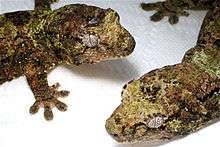Mniarogekko chahoua
Mniarogekko chahoua commonly known as the mossy New Caledonian gecko, short-snouted New Caledonian gecko, Bavay's giant gecko, or mossy prehensile-tailed gecko, is an arboreal gecko found natively on the southern portion of the island of New Caledonia and on the outlying islands of Île des Pins.
| Mniarogekko chahoua | |
|---|---|
 | |
| Scientific classification | |
| Kingdom: | Animalia |
| Phylum: | Chordata |
| Class: | Reptilia |
| Order: | Squamata |
| Family: | Diplodactylidae |
| Genus: | Mniarogekko |
| Species: | M. chahoua |
| Binomial name | |
| Mniarogekko chahoua | |
| Synonyms | |
| |
Conservation status
Mniarogekko chahoua is currently being evaluated by CITES as a possible candidate for protective status.
Taxonomy and systematics
Mniarogekko chahoua was first described in 1869 as Platydactylus chahoua by Arthur Bavay, a French pharmacist and herpetologist.[3][4]
Description
Mniarogekko chahoua gets its common name from the moss or lichen-like pattern it displays. Colors range from rusty red and brown to green or gray. There has been some notation that color could possibly be a geographic indicator in this species as the geckos from the outer islands most often display the lighter gray patterns. It commonly reaches a snout to vent length (SVL) of 5.5 in (14 cm). It possesses a strong, well-muscled, fully prehensile tail and is not subject to dropping it as readily as some of its relatives.
Diet
Mniarogekko chahoua, like all of the New Caledonian geckos, are omnivores. Their diet in the wild consists of various insects and fruits. They may also consume small lizards.
Reproduction
Mniarogekko chahoua lays two well calcified eggs that become adhered to one another shortly after laying. This is known as "egg gluing". Mniarogekko chahoua is the only Rhacodactylus gecko that lays adhering eggs. The eggs are generally laid on top of the substrate (generally behind loose tree bark) and are guarded by the female. The eggs hatch 60–90 days after laying.
Herpetoculture
This gecko is seen in herpetoculture but rarely. A male-female pair may be kept in a terrarium with a minimum size of 24 in × 18 in × 18 in (61 cm × 46 cm × 46 cm), but as with all arboreal geckos, the taller the enclosure the better. Plenty of hiding spaces including cork rounds and bushy plants should be used in the enclosure.
References
- Sadlier RA, Whitaker AH. (2011). "'Mniarogekko chahoua". IUCN Red List of Threatened Species. 2011. Retrieved 23 August 2012.CS1 maint: ref=harv (link)
- ITIS (Integrated Taxonomic Information System). www.itis.gov.
- The Reptile Database. www.reptile-database.org.
- Beolens B, Watkins M, Grayson M. (2011). The Eponym Dictionary of Reptiles. Baltimore: Johns Hopkins University Press. xiii + 296 pp. ISBN 978-1-4214-0135-5. (Rhacodactylus chahoua, p. 19).
Further reading
- Bauer AM, Jackman TR, Sadlier RA, Whitaker AH. (2012). "Revision of the giant geckos of New Caledonia (Reptilia: Diplodactylidae: Rhacodactylus)". Zootaxa 3404: 1-52. (Mniarogekko, new genus).
- Bavay A. (1869). "Catalogue des Reptiles de la Nouvelle-Calédonie et description d'espèces nouvelles". Mémoires de la Société Linnéenne de Normandie 15: 1-37. (Platycephalus chahoua, p. 3).
- Boulenger GA. (1885). Catalogue of the Lizards in the British Museum (Natural History). Second Edition. Volume I. Geckonidæ ... London: Trustees of the British Museum (Natural History). (Taylor and Francis, printers). xii + 436 pp. + Plates I- XXXII. (Rhacodactylus chahoua, pp. 177–178).
